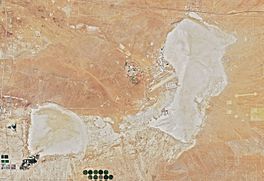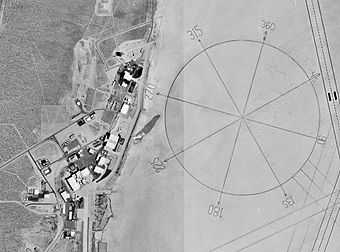Rogers Dry Lake facts for kids
Quick facts for kids Rogers Dry Lake |
|
|---|---|

Rogers Dry Lake (right) and Rosamond Lake (lower left) in Mojave Desert, California
|
|
| Location | Mojave Desert Kern County, California Los Angeles County, California |
| Coordinates | 34°55′19″N 117°49′39″W / 34.921944°N 117.8275°W |
| Lake type | Endorheic basin |
| Basin countries | United States |
| Max. length | 19 km (12 mi) |
| Max. width | 11 km (6.8 mi) |
| Surface area | 112 km2 (43 sq mi) |
| Shore length1 | 61 km (38 mi) |
| Surface elevation | 694 m (2,277 ft) |
| Settlements | Edwards Air Force Base |
|
Rogers Dry Lake
Edwards Air Force Base |
|
 |
|
| Location | Mojave Desert Kern County, California |
| Built | 1933 |
| NRHP reference No. | 85002816 |
| Significant dates | |
| Added to NRHP | 03 October 1985 |
| Designated NHL | 03 October 1985 |
| 1 Shore length is not a well-defined measure. | |
Rogers Dry Lake is a special kind of lakebed in the Mojave Desert in Kern County, California. It's called a "dry lake" because it's usually empty of water. It's also known as a "salt pan" because it has a flat, hard surface made of dried mud and salt.
This lakebed is a very important part of Edwards Air Force Base. Its super hard and flat surface acts like a natural extension of the paved runways. This allows even the biggest and heaviest airplanes to land safely. Rogers Dry Lake was once called Muroc Dry Lake. Its current name, Rogers, comes from an English version of the Spanish name, Rodriguez Dry Lake.
About Rogers Dry Lake
Rogers Dry Lake is located in the Antelope Valley, which is about 100 miles (160 km) north of Los Angeles. The lakebed covers an area of about 65 square miles (170 km2). It has a shape that looks a bit like a figure eight.
This dry lake formed about 2.5 million years ago. It is 12.5 miles (20.1 km) long and 5.5 miles (8.9 km) wide at its largest points. The ground of the lakebed is incredibly strong. It can handle a lot of pressure without cracking. This makes it perfect for aircraft landings.
During the short rainy season, water can collect on the lakebed. This water gathers at the lowest point, which is about 2,300 feet (694 meters) above sea level. Next to Rogers Dry Lake is a smaller lake called Rosamond Lake. Long ago, these two lakes were actually one big body of water.
History of the Lakebed
The area around Rogers Dry Lake was first used by railroads. There was a watering station nearby for steam trains. In 1910, a family named Corum tried to start a small town on the lakebed. They called it "Muroc," which is "Corum" spelled backward, but the town didn't last.
In 1933, the United States Army came to the area. They were looking for a place to set up a bombing range. They soon realized that the lakebed would be perfect for airplanes. In 1937, the United States Army Air Corps opened Muroc Air Field. This field was used for training and testing aircraft. Later, it became Edwards Air Force Base.
During World War II, something unusual was built on the lakebed. It was a 650 feet (200 m) replica of a Japanese warship. People nicknamed it "Muroc Maru". This fake ship was taken apart in 1950.
Edwards Air Force Base and Its Achievements
Many important things in aviation history have happened at Rogers Dry Lake. This includes testing new military planes. It's also where Chuck Yeager first broke the sound barrier. Even the Space Shuttle used to land here!
One of the most famous features of the lakebed is the world's largest compass rose. This giant compass is painted right onto the dry lake surface. Because of its importance, Rogers Dry Lake was named a National Historic Landmark in 1985.
The main runway at Edwards Air Force Base is called 04/22. It has a paved part that is 15,000 ft (4,600 m) long. It also has an extra 9,000 ft (2,700 m) of lakebed runway. This means it can handle any known aircraft.
There are seven other official runways on the Rogers lakebed:
- 17/35 is 7.5 mi (12.1 km) long and is a primary runway.
- 05/23 is 5.2 mi (8.4 km) long.
- 06/24 is 1.4 mi (2.3 km) long.
- 07/25 is 4.0 mi (6.4 km) long.
- 09/27 is 2.0 mi (3.2 km) long.
- 30 is 2.0 mi (3.2 km) long. (Runway 30 leads to the compass rose, so its opposite, runway 12, is not used).
- 15/33 is 6.2 mi (10.0 km) long.
- 18/36 is 4.5 mi (7.2 km) long.



